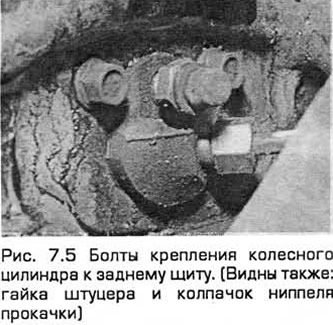Note: Before you start work, you need to purchase the necessary spare parts (seal repair kit). Also note that if the pads are dirty due to leaks from the wheel cylinder, they must be replaced. It is necessary to replace the entire set of pads on both brakes, even if only the brake on one side is dirty.
Withdrawal
1. Remove the brake drum (paragraph 5).
2. To minimize fluid leakage, remove the reservoir cap, place a piece of polyethylene underneath and tighten again to create an airtight seal. You can act in another way. Pinch the brake hose (next to the wheel cylinder) clamp.
3. Pull the brake shoes at their upper ends so that they do not interfere with the removal of the wheel cylinder. The automatic adjuster will hold the pads in this position so that the cylinder can be removed.
4. Wipe off the dirt around the fitting on the back of the wheel cylinder. Then unscrew the union nut.
5. Turn out two bolts of fastening of the wheel cylinder to a back board (see fig. 7.5).

6. Remove the wheel cylinder from the rear shield, freeing it from the blocks. Plug the openings in the connections to keep dirt out and to minimize fluid leakage when the cylinder is disconnected.
Repair
7. Clean the outer surfaces of the cylinder. Unscrew the hydraulic system bleed nipple.
8. Carefully remove the dust cover from both ends of the cylinder.
9. Tap the cylinder against a piece of wood to release the pistons and seals. Then remove the spring.
10. Wash the pistons and cylinder with methanol or clean brake fluid. Do not use gasoline, kerosene, or other mineral-based fluids for flushing. Remove and discard old seals, considering which side they were installed.
11. Inspect piston and cylinder surfaces for rust or nicks. If these signs are found, the entire wheel cylinder assembly must be replaced.
12. Lubricate the first piston with brake fluid. Then install the new seal so that the sealing lip faces away from the end of the piston that contacts the brake pad.
13. Insert the piston into the cylinder. When inserting the seal into the bore, rock the piston back and forth so that the seal lip does not bind.
14. Insert the spring. Then install the other piston and seals in the same way so that the lip does not stick when inserted into the hole.
15. Install new dust caps in the piston grooves and wheel cylinder housings.
16. Install the bleed nipple.
Installation
17. Wipe the rear shield and remove the plug from the end of the pipe. Place the cylinder on the rear shield and screw on the union nut by hand.
18. Tighten the mounting bolts. Then fully tighten the union nut.
19. Shorten the automatic adjuster so that the brake pads engage with the wheel cylinder pistons. To do this, slightly spread the pads by turning the adjuster, shorten it to a minimum and release the pads.
20. Remove the brake hose clamp or remove the plastic film from the reserve tank.
21. Install the brake drum (paragraph 5).
22. Remove air from the hydraulic system (paragraph 15). Provided that precautions are taken to minimize leaks, only the appropriate rear brake should be bled.
23. Before resuming travel by car, carefully check the brakes.
Visitor comments